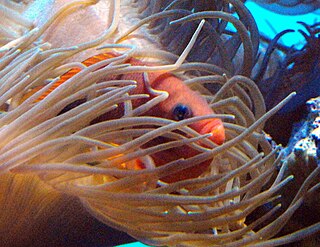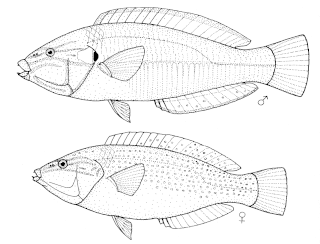
Amphiprion is a genus of ray-finned fish which comprises all but one of the species of clownfish or anemonefish in the subfamily Amphiprioninae of the family Pomacentridae.

Epinephelus is a genus of marine ray-finned fish, groupers from the subfamily Epinephelinae, part of the family Serranidae, which also includes the anthias and sea basses. They are predatory fish, largely associated with reefs and are found in tropical and subtropical seas throughout the world. They are important target species for fisheries.

Amblyglyphidodon is a genus of fish in the family Pomacentridae. These damselfish swim singly, in pairs, or in small groups. They are often found among corals.

Chromis is a genus of fish in the family Pomacentridae. While the term damselfish describes a group of marine fish including more than one genus, most damselfish are in the genus Chromis. These fish are popular aquarium pets due to their small size, tolerance for poor water quality, and bright colors, though their lifespans tend to be shorter than other fish.

Neoglyphidodon is a genus of fish in the family Pomacentridae.

Pomacentrus is a genus of marine damselfish in the family Pomacentridae. These fish inhabit tropical locations and are often captured or bred as aquarium fish.

Anampses is a genus of wrasses native to the Indian and Pacific Oceans.

Sardinella is a genus of fish in the family Clupeidae found in the Atlantic, Indian and Pacific Ocean. They are abundant in warmer waters of the tropical and subtropical oceans. Adults are generally coastal, schooling, marine fish but juveniles are often found in lagoons and estuaries. These species are distinguished by their ranges and by specific body features, but they are often confused with one another. Fish of the genus have seven to 14 striped markings along the scales of the top of the head. The paddle-shaped supramaxilla bones are characteristic; they separate Sardinella from other genera and their shapes help distinguish species. They have paired predorsal scales and enlarged fin rays.

Lutjanus is a genus of snappers found in the Atlantic, Indian, and Pacific Oceans. They are predatory fish usually found in tropical and subtropical reefs, and mangrove forests. This genus also includes two species that only occur in fresh and brackish waters.

Lutjanidae, or snappers. are a family of perciform fish, mainly marine, but with some members inhabiting estuaries, feeding in fresh water. The family includes about 113 species. Some are important food fish. One of the best known is the red snapper.

Dischistodus prosopotaenia is a species of damselfish known by the common names honey-head damsel and honey-breast damsel. It is native to the eastern Indian Ocean and western Pacific. It reaches up to 17 centimetres (6.7 in) in length. The fish usually has a white breast, but there is a yellow-breasted variant that also has a black blotch on each side. The fish lives in lagoons and reefs.

The humpback red snapper or paddletail snapper, Lutjanus gibbus, is a species of snapper native to the Indian Ocean from the coast of Africa and the Red Sea to the western Pacific Ocean. It is mostly an inhabitant of coral reefs at depths of from 1 to 150 m, with the juveniles being found in beds of seagrass or on sheltered coral reefs and subadults and adults found on sloping substrates. This species can reach a length of 50 cm (20 in). It is a commercially important species, as well as being sought after as a game fish. It is also a popular species for display in public aquaria. It has been reported to cause ciguatera poisoning.

Pterocaesio is a genus of fusiliers found in the Indian and Pacific oceans, with these currently recognized species:

Gerres is a genus of mojarras found mostly in coastal regions from the eastern Atlantic Ocean through the Indian Ocean to the western Pacific. A single species, G. simillimus, is from the East Pacific. They mainly inhabit salt and brackish waters, but will enter fresh water.

Pristipomoides is a genus of snappers native to the Atlantic, Indian and Pacific oceans.

Pentapodus is a genus of threadfin breams native to the eastern Indian Ocean and the western Pacific Ocean.















